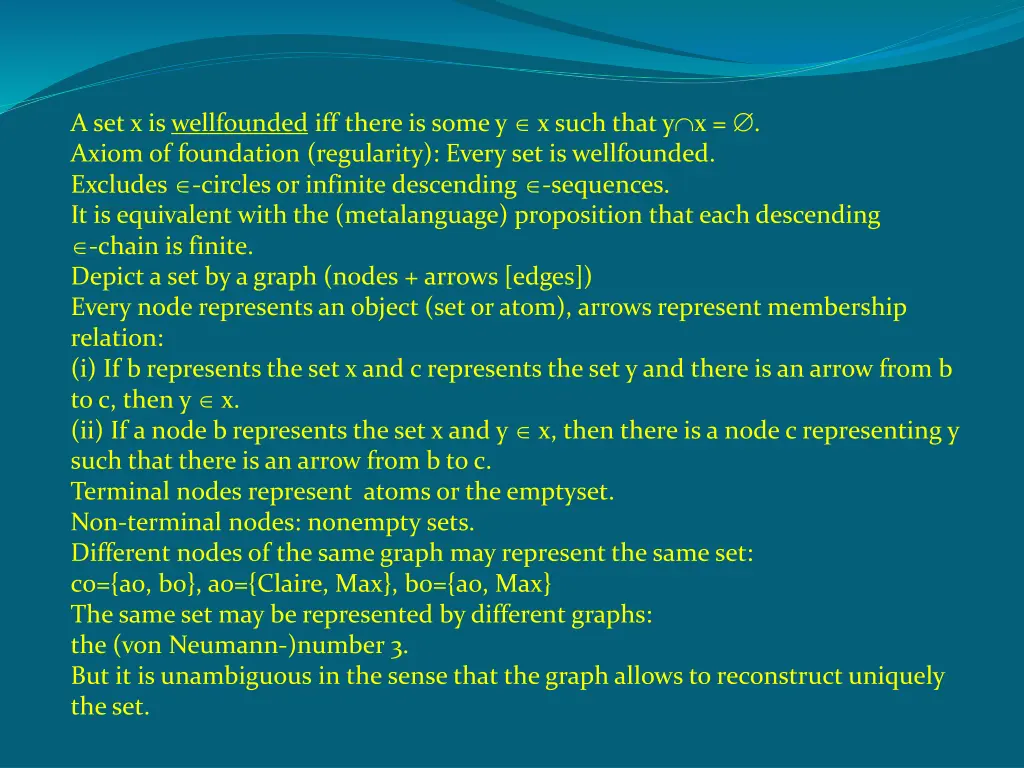
Graphical Representation of Wellfounded Sets and Tagged Graphs
Explore the concept of wellfounded sets through graphical representation in set theory, focusing on the axiom of foundation and the uniqueness of set representation in graphs. Additionally, delve into tagged graphs and their formalization, exemplified through exercises involving propositions expressible in English using a set number of words.
Download Presentation

Please find below an Image/Link to download the presentation.
The content on the website is provided AS IS for your information and personal use only. It may not be sold, licensed, or shared on other websites without obtaining consent from the author. If you encounter any issues during the download, it is possible that the publisher has removed the file from their server.
You are allowed to download the files provided on this website for personal or commercial use, subject to the condition that they are used lawfully. All files are the property of their respective owners.
The content on the website is provided AS IS for your information and personal use only. It may not be sold, licensed, or shared on other websites without obtaining consent from the author.
E N D
Presentation Transcript
A set x is wellfounded iff there is some y x such that yx = . Axiom of foundation (regularity): Every set is wellfounded. Excludes -circles or infinite descending -sequences. It is equivalent with the (metalanguage) proposition that each descending -chain is finite. Depict a set by a graph (nodes + arrows [edges]) Every node represents an object (set or atom), arrows represent membership relation: (i) If b represents the set x and c represents the set y and there is an arrow from b to c, then y x. (ii) If a node b represents the set x and y x, then there is a node c representing y such that there is an arrow from b to c. Terminal nodes represent atoms or the emptyset. Non-terminal nodes: nonempty sets. Different nodes of the same graph may represent the same set: c0={a0, b0}, a0={Claire, Max}, b0={a0, Max} The same set may be represented by different graphs: the (von Neumann-)number 3. But it is unambiguous in the sense that the graph allows to reconstruct uniquely the set.
Which graphs represent sets? In ZF, it is a trivial necessary condition that the graph does not contain circles. Not trivial: it is sufficient, too. Non-wellfounded set theory: Circles are allowed, too. There is a set such that = { } It can be depicted by many different graphs. Is there only one set x such that x={x}? If we want to keep the property that the set can be uniquely reconstructed from the graph, we must say no. But it doesn t follow from Extensionality. AFA s idea: (under some simple conditions) every nonterminal node of a graph represents one and only one nonempty set. The edges of the graph represent the hereditary membership relation in the sense that y belongs to the hereditary members of x (in other words: to the transitive closure of x iff there is a path from x to y. Another example (a non-wellfounded variant of the previous): c={a,b}, a={Claire, Max, b}, b={a, Max}
Some terminology and notation in order to formalize the idea: Graph: An X set of nodes + an R X X set of arrows/edges. The fact that <x,y> R can be written in this form: x y. We call y a child of x. A node is childless (terminal) iff there is no such y. G is a tagged graph: there is a function tag(x) that assigns an atom or the emptyset to each childless node of G. Decoration of a tagged graph G is a function D(x) that assigns a set or an atom to each node of G with the following conditions: (i) If x is a childless node, then D(x) = tag(x) (ii) If x has children, then D(x) = {D(y) : x y} AFA, formal version: every tagged graph has an unique decoration. We can prove the existence and the unicity of the previous no-wellfounded examples.
Exercises Let us regard the following sentence: This proposition is not expressible in English using ten words Let E be the atom representing the property expressible in English using ten words and let us represent the proposition that a proposition has/has not this property with the triple <E, p, 1>/<E, p,0 > (leaving off the atom Prop for the sake of simplicity). If we have a graph Gprepresenting p, a graph representing that p is not expressible in English using ten words will be that on Figure 7. If this proposition in the above sentence refers to the prop expressed by the sentence itself, q, then q = <E, q, 0> and a graph representing q can be seen on Figure 8.
